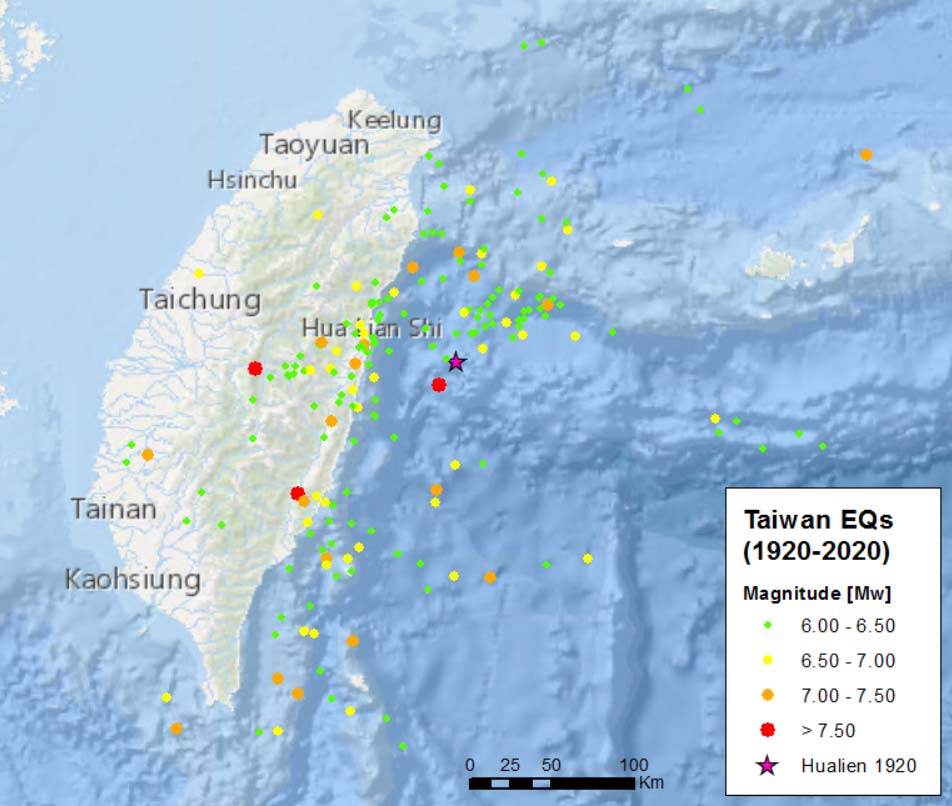June 5, 2020, marks the centenary of the 1920 Hualien earthquake, a devastating M8.1 event (recently revised to Mw7.8) and the largest temblor ever recorded instrumentally in Taiwan. Although this event is the strongest ever recorded in Taiwan, it was not as devastating as other events in the region: It resulted in 8 deaths, 24 injuries, and some building destruction concentrated in the most populated areas, including Taipei, Taoyuan, Hsinchu, and Taitung. Nevertheless, it highlights seismic risk in Taiwan.
The earthquake’s epicenter was located about 50 km east of Hualien, on the west side of the Hoping seismicity cluster; however, the exact mechanism for this event is still under debate within the scientific community. The most widely accepted scenario is that the rupture occurred at the interplate seismogenic zone along a shallow splay fault followed by a downward/lateral propagation of the rupture, which can explain the absence of a tsunami.
Seismic Activity in Taiwan in the Last Century
More than 180 earthquakes of M6.0 or greater have occurred in Taiwan in the last century, with 26 of those events exceeding M7.0 (Figure 1).
Most notably, the M7.6 Chi-Chi earthquake that struck central Taiwan on September 21, 1999, caused 2,415 deaths and more than 11,000 injuries. Damage from this earthquake was extensive, as approximately 100,000 houses and 786 schools were destroyed or severely damaged. The Chi-Chi earthquake ruptured along a 100-km segment of the Chelungpu thrust fault at a focal depth of 8 km, and a 20 km-wide rupture zone. Prior to this event, two M7.1 earthquakes struck Taiwan—Taizhong in 1935 and Zhongpu in 1941—claiming the lives of more than 3,000 and 4,500 people, respectively, and causing extensive damage to buildings and infrastructure island-wide. More recently, an M6.4 earthquake struck north of Hualian, a city in the north of Hualien County, on February 6, 2018, damaging mainly older, soft-story buildings.

Taiwan’s Seismotectonic Setting
Taiwan is located at the collision zone between the Philippine Sea Plate and the Yangtze microplate of the Eurasian Plate, which has resulted in the rise of the Central Mountain range, producing subduction, orogeny, and widespread thrust faulting around the island. The major active fault zones in Taiwan include the Deformation Front in the western foothills of the Central Mountain range and the Longitudinal Valley Fault zone in the east. In addition to these major inland active fault zones, the Ryukyu subduction zone at the eastern offshore and the northern extension of the Manila Trench subduction zone in the southern offshore areas are also major active seismic zones that can impact Taiwan.
The AIR Earthquake Model for Southeast Asia
Situated in one of the most tectonically complex and active regions in the world, Taiwan is regularly impacted by moderate-to-large seismic events. Past events in the last hundred years have taught us that the multiple seismic sources surrounding Taiwan can cause significant damage to areas of concentrated exposure. In addition, one should not ignore that the region is also prone to tsunami risk, with two major tsunami events impacting the island in that last 250 years.
The AIR Earthquake Model for Southeast Asia incorporates the complex seismicity of Taiwan by generating events along known crustal faults, in subduction zones, and within a number of seismic source zones through smoothed background seismicity. In addition, the model explicitly captures the liquefaction risk and quantifies probabilistically the risk of damaging tsunamis in the region.
Read the blog “Premium International Geocoding for More Accurate Risk Estimation”




